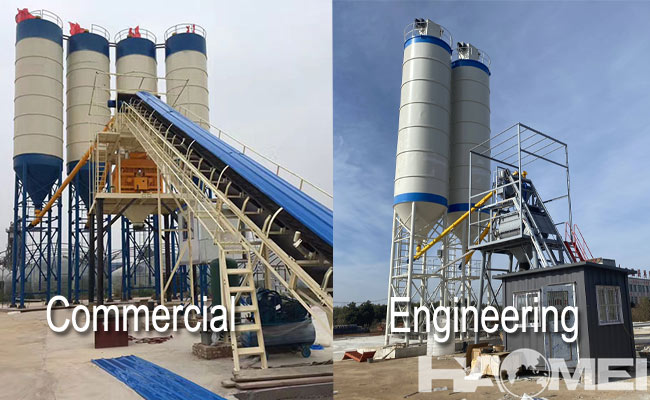Different Types of Concrete Batching Plant
Writer:Admin Time:25/06/06Concrete batching plant is a combined device for centralized mixing of concrete. It can be divided into many types according to different classification standards.
The following is an introduction to common types of concrete batching plants:
1. Classification by mixing host type
(1). Free-fall concrete batching plant
- Working principle: The materials are repeatedly dropped and mixed by their own gravity by the rotation of the blades in the mixing drum.
- Features: Simple structure and low energy consumption, but low mixing intensity and slow efficiency. It is suitable for mixing plastic concrete with high fluidity and low-strength concrete.
- Applicable scenarios: Small construction sites, rural projects and other projects with low requirements for concrete performance.
(2). Forced concrete batching plant
- Working principle: The materials are forced to be pushed by the rotating shaft and blades in the mixing drum so that they are mixed in violent shearing and flipping.
- Features: High mixing efficiency and good uniformity. It can mix dry hard, semi-dry hard and high-strength concrete, but the energy consumption is high and the equipment wear is large.
- Applicable scenarios: large-scale construction projects, commercial concrete production, bridges/tunnels and other high-strength concrete demand scenarios.

2. Classification by production capacity
(1). Small concrete batching plant
- Capacity: The output per hour is usually 25 - 50 cubic meters.
- Features: small footprint, simple equipment, low investment cost, flexible mobility.
- Applicable scenarios: small construction sites, rural housing construction, small municipal projects.
(2). Medium-sized concrete batching plant
- Capacity: about 60-90 cubic meters per hour.
- Features: moderate degree of automation, taking into account efficiency and cost, can meet the needs of medium-sized projects.
- Applicable scenarios: ordinary commercial housing construction, road construction, small and medium-sized concrete prefabrication plants.
(3). Large concrete batching plant
- Capacity: more than 90 cubic meters per hour, up to 240 cubic meters and above.
- Features: high degree of automation, complex equipment, large output, often equipped with multiple mixing hosts and intelligent management systems.
- Applicable scenarios: commercial concrete batching plant, large infrastructure projects (such as high-speed rail, airports, water conservancy projects).
3. Classification by mobile mode
(1). Stationary concrete batching plant
- Features: fixed installation in a specific site, large equipment, stable production capacity, and infrastructure construction is required.
- Applicable scenarios: commercial concrete batching plant with long-term production, large engineering site.
(2). Mobile concrete batching plant
- Features: integrated on the vehicle chassis or detachable modules, easy to transport and transfer, quick installation.
- Applicable scenarios: field construction, temporary projects (such as construction along roads and railways), projects that require frequent site changes.
4. Classification by use
(1). Commodity concrete batching plant
- Features: mainly producing commercial concrete, supplying to the society, with large production capacity and high degree of automation, and must comply with industry standards and environmental protection requirements.
- Configuration: usually equipped with multiple forced mixers, large silos, precise metering systems and environmental protection equipment (such as dust collection, wastewater treatment).
(2). Engineering dedicated concrete batching plant
- Features: tailored for specific projects (such as bridges, tunnels, water conservancy hubs), production capacity is designed according to project needs, and is highly targeted.
- Scenario: construction of large-scale projects such as the Three Gorges Dam and cross-sea bridges.
(3). Concrete precast batching plant
- Features: used to produce concrete precast components (such as pipe piles, floor slabs, bridge components), which must meet the special ratio and performance requirements of component production.
- Configuration: Often equipped with high-precision metering systems and maintenance equipment to ensure the stability of prefabricated parts.
5. Classification by aggregate storage method
(). Storage silo type concrete batching plant
- Features: Aggregates are stored in closed or semi-closed silos and transported to the mixing host by belt conveyors or elevators, with a high degree of automation.
- Applicable scenarios: Large fixed batching plants, suitable for continuous production.
(2). Open-air stacking concrete batching plant
- Features: Aggregates are stacked in the open air and loaded by loaders. The equipment is simple and the investment is low, but it is greatly affected by the weather and the dust pollution is serious.
- Applicable scenarios: Small temporary batching plants and construction sites with low environmental protection requirements.
6. Classification by degree of automation
(1). Fully automatic concrete batching plant
- Features: PLC control system is used to realize automatic metering, transportation and mixing of aggregates, cement, water and additives, and data can be monitored and managed in real time.
- Advantages: High production efficiency, accurate ratio, reduced manual errors, suitable for large-scale standardized production.
(2). Semi-automatic concrete batching plant
- Features: Some links (such as metering and loading) require manual assistance, and the degree of automation is low.
- Applicable scenarios: small and medium-sized construction sites, projects with low automation requirements, and relatively low costs.
Each type of concrete batching plant has its specific applicable scenarios and advantages and disadvantages. Choosing the right type of concrete batching plant can improve construction efficiency and concrete quality.
- Previous:What Is A Stationary Concrete Batch Mix Plant?...
- Next:Concrete Batching Plant HZS50 VS HZS60...

